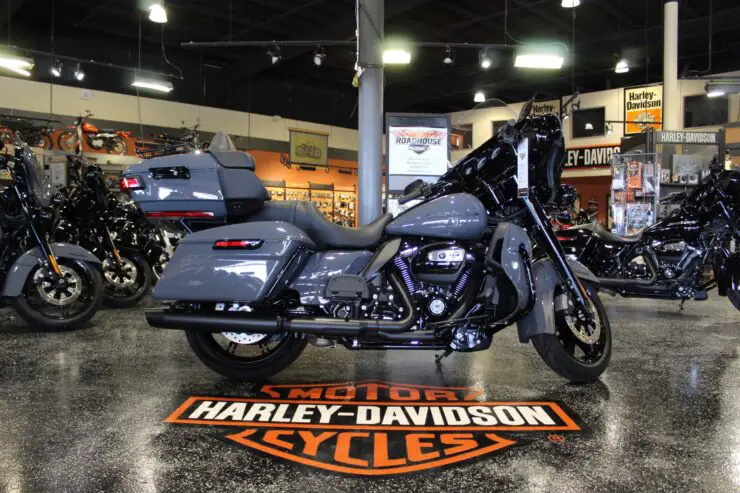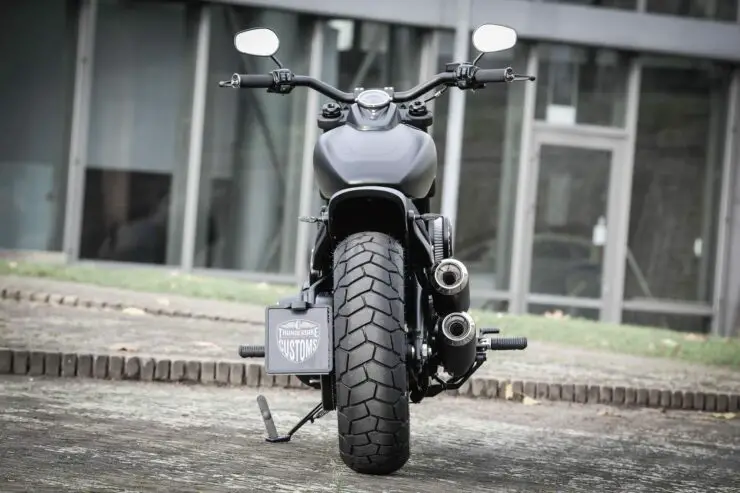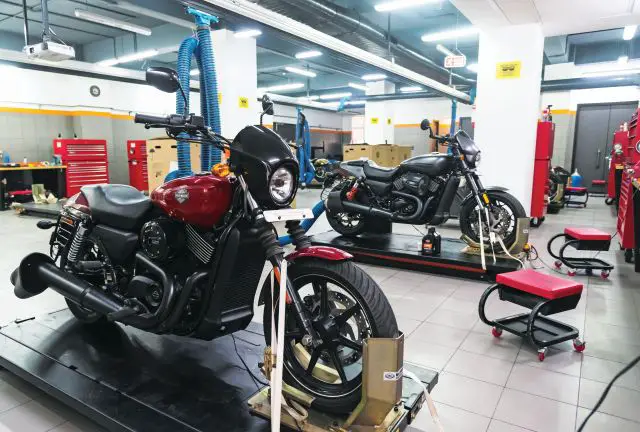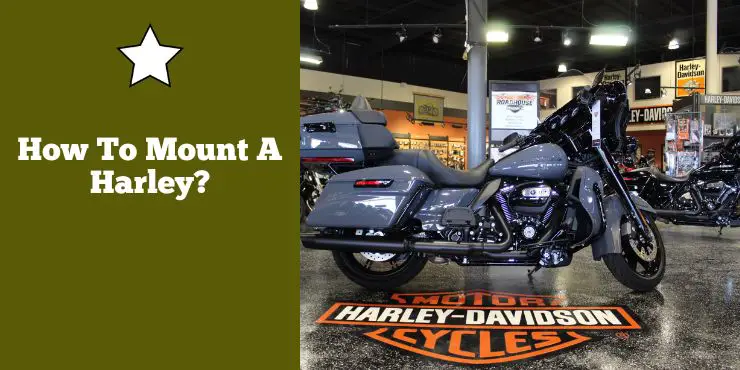Are you eager to learn how to mount a Harley? If yes, you have come to the right place!
In this article, you will learn all the necessary steps to mount a Harley. With this step-by-step guide, you will be able to mount your Harley like a pro in no time. So, let’s begin!
To mount a Harley, stand on the left side, grasp the handlebar, lift your leg over the seat, and sit while keeping the bike balanced. Ensure feet are securely on the ground.
Safety precautions to take when mounting a Harley-Davidson bike

Mounting a Harley-Davidson motorcycle is an easy but essential process but you’ll still need to prioritize safety throughout the process. By following proper safety precautions, you’ll be able to minimize the risk of accidents or injuries and ensure a safe and enjoyable ride. Here are the safety measures you need to consider when mounting your Harley-Davidson motorcycle.
How To Mount A Big Flag On A Motorcycle: Know All About Mounting A Flag On Your Harley
#1. Wear proper safety gear
Before mounting your Harley-Davidson motorcycle, you should always wear the appropriate safety gear. This includes a DOT-approved helmet, eye protection (such as a face shield or goggles), sturdy footwear (motorcycle boots), protective gloves, and suitable riding attire like a jacket and pants made of abrasion-resistant material. Wearing proper safety gear will provide essential protection in case of an accident or fall.
#2. Choose a suitable mounting area
Select a well-lit, flat, and stable area for mounting your Harley. Make sure that the surface is free of debris, oil, or other hazards that might cause slips or instability. Avoid parking on an incline or uneven ground as it can affect your balance and control while mounting.
#3. Securely park the bike
Before attempting to mount your Harley-Davidson bike, make sure it is properly parked and securely supported. Place the bike on its kickstand on a level surface. Confirm that the kickstand is fully engaged and stable. If you are on an uneven surface or require additional stability, consider using a wheel chock or a motorcycle stand for added support.
#4. Maintain a clear area
Clear the area around the bike to ensure there are no obstacles or hazards that might impede your movement while mounting. Remove any loose objects, tools, or accessories from the mounting area to prevent tripping or potential damage to the bike.
#5. Check the bike’s stability
Before mounting, you should check the bike’s stability by gently rocking it from side to side. Make sure that it remains balanced and stable. If you notice any excessive movement or instability, reassess the pointing and support of the bike before attempting to mount it.
#6. Use the proper mounting technique
When mounting your Harley, use a proper technique for ensuring your safety. Stand on the left side of the bike, holding the handlebars firmly. Place your left foot on the footpeg or floorboard, and using your leg muscles, lift yourself onto the bike while still maintaining a firm grip on the handlebars. Avoid making any sudden movements or jerking motions that can affect balance.
Different methods for how to mount a Harley-Davidson bike
Mounting a Harley-Davidson motorcycle is an important skill for riders and there are various methods you can choose from depending on the situation and personal preference. Whether you are mounting while stationary, using the kickstand, or performing a moving mount, each method comes with its unique advantages and considerations. Here are the distinct methods for mounting a Harley-Davidson motorcycle and the steps for each approach.
Stationary mount
The stationary mount is the most common approach for mounting a Harley-Davidson bike. It is performed while the bike is stationary and it offers stability and control during the process. Here are the steps you should follow for stationary mounting your bike –
First, you need to position your bike. Make sure that your bike is parked on a level surface and properly supported with the kickstand engaged or using a motorcycle stand. Now, stand on the left side. Stand on the left side of the motorcycle, facing the front, with your left foot positioned on the ground.
Then, grip the handlebars. Firmly grip the handlebars with both hands while keeping your body balanced and upright. Now, lift yourself onto the bike. Using your leg muscles, you should push yourself up and onto the bike, lifting your body onto the seat. Maintain your balance by keeping your weight centered and distributed evenly.
Then, settle into position. Once seated, you should adjust your footing onto the footpegs of the floorboards. Make sure that your hands have a comfortable grip on the handlebars. Take a moment to ensure that your body is positioned properly for control and stability.

Kickstand mount
The kickstand mount is an alternative method that involves mounting the bike while it remains on the kickstand. This method is especially useful when parking on uneven surfaces or when additional stability is needed. Here are the steps you will have to follow for carrying out a kickstand mount –
First, you should position your bike. Park your bike on a level surface and engage the kickstand securely. After that, you should stand on the left side of the bike, facing the front, with your left foot positioned on the ground.
Use the kickstand for additional support. Hold the handlebars with your left hand and place your right hand on the seat or rear grab rail for support.
Now, use your leg muscles to push yourself up and onto the motorcycle while utilizing the kickstand as a support. Be mindful of the motorcycle’s balance and keep your weight centered. Then, settle into position. Once seated, you need to adjust your footing and hand position as necessary, ensuring a comfortable and secure grip.
Moving mount
The moving mount is an advanced technique commonly used by experienced riders and it involves mounting the bike while it is already in motion. This method is typically used in specific scenarios like a quick stop or when traffic conditions require immediate movement. Here are the steps you will have to follow for carrying out a moving mount –
First, you need to assess the situation. Make sure it is safe and appropriate to perform a moving mount. This method is best suited for experienced riders comfortable with their bike’s balance and control.
Then, you should apply slow braking. Gradually reduce the motorcycle’s speed by lightly applying the brakes as you approach a stop. As your bike slows down, you should place your left foot on the ground while maintaining control of the bike with both hands on the handlebars.
Now, you should lift yourself onto the bike. With your bike in a controlled, slow-motion stop, use your leg muscles for pushing yourself up and onto the bike to lift your body onto the seat. Keep your weight centered and maintain control of your bike.
Once you are on the seat, you must adjust your footing and hand position as needed, ensuring a secure and balanced grip.
Tips to make mounting your Harley-Davidson bike easier
Mounting a Harley-Davidson bike can sometimes be challenging, especially for new riders or those with physical limitations. However, with a few helpful tips and techniques, you will be able to make the process of mounting your bike easier and more convenient. Here are the tips you must remember to make the mounting process easier.
#1. Choose the right footwear
Wearing suitable footwear can significantly improve your grip and stability when mounting a Harley-Davidson motorcycle. Opt for sturdy motorcycle boots or shoes with non-slip soles that provide excellent traction on various surfaces. Avoid wearing loose or open-toed footwear that might impede your ability to grip the footpegs or floorboards securely
#2. Utilize a mounting aid
If you need additional support or assistance, you should consider using a mounting aid or step. These devices attach to the bike and provide a stable platform for you to step onto before mounting. They can be especially helpful for bikers with limited mobility or those who need extra support during the mounting process.
#3. Take advantage of passenger handles
If your Harley-Davidson motorcycle is equipped with passenger handles, utilize them to provide extra support when mounting. These handles can offer a secure grip and help you maintain balance as you lift yourself onto the bike. Place your hand on the passenger handle while gripping the handlebars with the other hand to enhance stability.
#4. Use a kickstand support plate
A kickstand support plate is a small accessory that provides a broader surface area for the kickstand, preventing it from sinking into soft or uneven surfaces. By using a kickstand support plate, you’ll be able to ensure a stable base for your bike, making it easier to mount without worrying about balance or stability issues.
#5. Maintain regular exercise and flexibility
Improving your overall fitness and flexibility can greatly contribute to easier mounting. Regular exercise, particularly focusing on core strength and leg flexibility, can improve your ability to maneuver and mount your Harley-Davidson bike with greater ease. Engage in exercises such as yoga, stretching, and strength training to improve your body’s agility and balance.
#6. Practice mounting techniques
Remember, practice makes perfect. Spend time practicing different mounting techniques, in a controlled and safe environment. By repeatedly performing the motions, you’ll develop muscle memory and become more confident in your ability to mount the bike smoothly.
Common mistakes to avoid when mounting a Harley-Davidson bike
Mounting a Harley-Davidson motorcycle will be a simple and effortless task but it isn’t uncommon for riders to make mistakes that can complicate this process. By understanding these mistakes and knowing how to avoid them, you’ll be able to make mounting your bike easier and more enjoyable. Here are some of the common mistakes people make when mounting a Harley-Davidson bike.
#1. Incorrect foot placement
One of the most prevalent mistakes people make is placing their feet incorrectly when mounting the bike. Avoid resting your weight on the top of your toes or the ball of your foot. Instead, make sure that both feet are planted firmly on the ground, providing a stable foundation. This will give you better balance and control when lifting yourself onto the bike.
#2. Poor body positioning
Improper body positioning can make mounting a Harley-Davidson motorcycle more challenging. You should avoid leaning too far to one side or hunching yourself as you prepare to mount. Instead, you should maintain an upright posture with your body centered and aligned. Distribute your weight evenly to ensure stability and a smoother mounting experience.
#3. Rushing the process
Many riders make the mistake of rushing when mounting their bike. Whether it is due to excitement or impatience, rushing can result in missteps and loss of balance. Take your time and approach the process calmly and deliberately. This will allow you to position yourself correctly and ensure a secure grip before lifting yourself onto the bike.
#4. Neglecting safety measures
Failing to prioritize safety is another mistake when mounting a Harley-Davidson bike. You must wear the appropriate safety gear, including a helmet, gloves, and protective clothing. These items will not only protect you in the event of a fall but they’ll also provide the needed support and confidence during the minting process.
#5. Ignoring bike stability
Before attempting to mount your Harley, ensure that it is on a stable surface and properly supported. Check that the kickstand is securely engaged or use a motorcycle stand if needed. Neglecting to assess the bike’s stability can result in unexpected movement or loss of balance during the mounting process.
#6. Lack of surrounding awareness
Many bikers overlook their surroundings when mounting a Harley-Davidson bike. You should take a moment to survey the area for potential hazards or obstacles that can interfere with your mounting process. Look for loose gravel, uneven terrain, or objects that might cause a slip or trip. By being aware of your surroundings, you’ll be able to adjust your approach accordingly and minimize the risk of accidents.

Troubleshooting issues when mounting a Harley-Davidson bike
Mounting a Harley-Davidson motorcycle is an important moment for bikers, but occasionally, issues may arise and hinder things. Whether it is mechanical problems, discomfort, or safety concerns, troubleshooting these issues will be important. Here are some of the issues that riders might encounter when mounting a Harley and how to troubleshoot them.
#1. Unstable kickstand
One of the most common issues when mounting a Harley-Davidson motorcycle is an unstable kickstand. If you find that your bike wobbles or feels unsteady when you try to mount it, check the kickstand for proper engagement. Make sure that it is fully extended and locked in place. If the kickstand is damaged or malfunctioning, it might have to be repaired or replaced.
#2. Uncomfortable seat position
If you experience discomfort or strain in your seating position after mounting your bike, it is important to address the issue promptly. Start off by adjusting the seat to a position that provides optimal comfort and support. Experiment with different seat heights, angles, and positions to find the most comfortable setup for your body type and riding style. If needed, you should consider investing in an aftermarket seat that offers better cushioning and ergonomics.
#3. Handlebar misalignment
Misaligned handlebars can cause discomfort and affect your control over the bike. If you notice that the handlebars aren’t aligned properly after mounting, it is important to adjust them. Loosen the handlebar clamps and adjust the position until they’re straight and aligned with your riding posture. Tighten the clamps securely to ensure stability.
#4. Sticky or unresponsive controls
If you encounter sticky or unresponsive controls after mounting your bike, it is important to address the issue before riding. Start by checking the cables and control mechanisms for any signs of damage or obstruction. Lubricate the cables if needed and ensure they move freely. If the issue still persists, it might be necessary to consult a professional mechanic for a thorough inspection and repair.
#5. Uneven tire pressure
Uneven tire pressure can end up affecting the stability and handling of your Harley-Davidson motorcycle. Before mounting, you should visually inspect the tires for any signs of damage or wear. Check the tire pressure using a reliable pressure gauge and ensure that both tires are inflated to the manufacturer’s recommended specifications. Uneven tire pressure can be corrected by adding or releasing air as needed.
#6. Loose or fault fasteners
After mounting your bike, take a moment to inspect the bike for any loose or faulty fasteners. Check critical components such as the handlebars, footpegs, mirrors, and fenders. Tighten any loose fasteners to ensure they are secure. If you notice any damaged or worn fasteners, you should replace them promptly.
#7. Strange noises or vibrations
If you hear any unusual noises or experience excessive vibrations after mounting your bike, it is important to investigate the source of the problem. Check for loose components, such as exhaust pipes or engine covers. Inspect the bike for any signs of damage or mechanical issues. If the issue still persists, it is advised to seek assistance from a professional Harley-Davidson mechanic to diagnose and address the issue.
FAQs
What if I am too short to mount a Harley?
If you are too short to mount a Harley, consider investing in lowering kits or adjustable suspension systems to make the bike more accessible.
What is the best way to mount a Harley for beginners?
The best way to mount a Harley for beginners is to start with the stationary method and practice until you feel comfortable
Can I mount a Harley without a kickstand?
It is possible to mount a Harley without a kickstand, but it requires more skill and balance. Use caution and practice in a safe, controlled environment.
What are the most common mistakes made when mounting a Harley?
The most common mistakes when mounting a Harley include not using the correct mounting technique, not checking the bike’s condition, and not wearing the proper gear.

